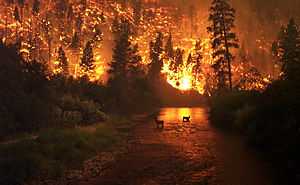Mount Lubra bushfire
| Part of a series on wildland firefighting | |||
|---|---|---|---|
 | |||
| Main articles | |||
| Tactics & equipment | |||
|
Aerial firefighting · Controlled burn · Driptorch · Fire apparatus · Firebreak · Fire fighting foam · Fire hose · Fire lookout tower · Fire retardant · Fire-retardant gel · Fire trail · Helicopter bucket · Hose pack · Pulaski · Wildland fire engine · Wildland fire tender | |||
| Personnel | |||
|
Engine crew · Handcrew · Helitack · Hotshots · Lookout · Smokejumper · Rappeller | |||
| By country | |||
| Lists | |||
The Mount Lubra bushfire was started by a lightning strike in January 2006 near The Grampians in Australia. The fire began late on 19 January 2006. By the time it was extinguished it had burned for approximately two weeks and covered approximately 130,000 hectares of land.
The fire burned, in difficult terrain, throughout 20–21 January without any serious impact. On 22 January, hot and dry conditions that had persisted for several days worsened. The fire spread rapidly in a southerly direction towards Dunkeld, south of Grampians National Park. The fire front reached the outskirts of Willaura (south-west of Ararat), before a strong but dry wind change took the fire back in the opposite direction. Winds of up to 120 km/h sent the fire northward extremely quickly, impacting a number of small communities along the eastern side of The Grampians, including Mafeking, Moyston, Barton, Jallukar and Pomonal. A man and his son died between Moyston and Pomonal when they were caught up in the fire.[1] The fire was eventually controlled approximately two weeks later, having burned nearly 47% of the Grampians National Park, as well as a significant amount of private property, a total of 184,000 hectares. Approximately 25 homes were destroyed, mostly to the west of Moyston and around Pomonal. Over 50 sheds and outbuildings, 1500 kilometres of fencing, as well as 62,000 head of sheep and 500 head of cattle were lost to the blaze.[2][3] (p26)[4][5]
See also
- 2005-06 Australian bushfire season
References
- ↑ http://www.thecourier.com.au/news/local/news/general/bushfire-deaths-inquest-begins/241077.aspx
- ↑ "Rain reduces Victoria bushfire threat - Breaking News - National - Breaking News". Smh.com.au. 2006-01-29. Retrieved 2012-07-28.
- ↑
- ↑
- ↑ "Rain eases bushfire fears - National". theage.com.au. 2006-01-29. Retrieved 2012-07-28.